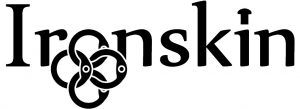What? About mail armor and chainmail
Medieval times make us think of noble knights in costly armor. At Ironskin we’re fascinated, by how rigid pieces of metal can be connected to form mobile garments. Armor made from rings appears particularly elegant to us. It can flow around a body like iron skin. Such armor arouses a feeling of being invulnerable and agile at the same time. The weight distributes evenly around the shoulders, hips, and arms. Thus it even feels light with 6 to 14kg of weight. Unlike plate armor it can be worn by wearers of different sizes and damages can be repaired inexpensively. Rust is not a problem, because the permanent friction of the rings helps to sand it off. All this makes ring armor precious and utile pieces of art. They can be passed on from generation to generation without losing their value or fascination.
You might have noticed, that we didn’t use the word chainmail in the last paragraph. Although it is quite common in colloquial language, we try to avoid it. That being said, we do use the word chainmail here to help you find this site. However, the term chainmail delivers the wrong impression, that rings are strung in lines like a chain. Yet instead of one-dimensional chains, rings are connected to two-dimensional weaves. Such a weave can be shaped just like knitting. It can thus cover a heel or a shoulder without corners or edges. To do that, some rings have to hold fewer or more neighbors as usual in the pattern. Consequently human body shape can be reconstructed very well-fitting. Weight can be cut down while mobility is preserved. Therein lies the true art of making good mail armor.
Unfortunately, only a rare fraction of modern mail armor shows this elegant shaping. Most modern chain mail is constructed in a primitive manner instead. It is cut and sewn like cloth. In my opinion, good mail armor is not woven and sewn like a shirt, but rather knitted like knitted fabric. That way it doesn’t show folds and doesn’t need excessive material. It rather fits the shape of a body like a second skin. With this site, I want to help you get well-fitting made-to-measure chain mail yourself.
Why? What brings you to such an extraordinary passion?
As mentioned, mail armor has got a fascination on its own, which sparked our motivation to learn more about it. Furthermore, mail armor found to buy is seldom made-to-measure. It is typically not well-shaped and thus heavier. The rings contain weak points like poorly positioned rivets or protruding sharp ends. We learned that higher quality can be achieved by commissioning a skilled person or building mail armor yourself.
For people with a lot of money and only a little time, it is a good compromise to buy rings. Consider, that you usually have to sort out up to 40% of the rings. That way you can build the mail armor of your choice. Yet you won’t experience the joy of experimenting with ring production. Little is known about the exact methods and tools of medieval and ancient mail makers. So there is a big playground for experimental archaeology. If you take this path, you get rewarded with light and strong rings. They exceed the quality of machine-made rings and get closest to historical ones. This site is also meant to give you some help with that.
How? About electric drills and hand-driven cranks
To be honest: Although mail armor still has its application as protection for butchers or special forces, our motivation is enthusiasm for history. Thus the priority is to make our creations as accurate as possible to historic originals. Nevertheless, in the process of achieving this, modern tools and methods should not be excluded. By using them, we can learn and build faster. We use modern annealed wire for example, although knowing, that it doesn’t contain slag as medieval wire did. If we would smelt all the iron ourselves, we wouldn’t have finished a single mail shirt until today.
The important thing is to master both historic and modern methods and to know about their different results. This means that we use a manual crank when we display coiling wire at an event. At the workshop, however, we use an electric drill instead. The results are the same. Astonishingly many historic methods work better than modern ones. For example, rivet holes can be punched faster and more precisely than drilling them. Many steps in making mail armor depend on personal choice and a lot can be learned by exchanging with other mail makers.
Check out all the tutorial articles!
Have look at our previous commission works!
